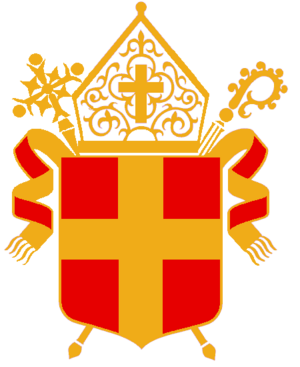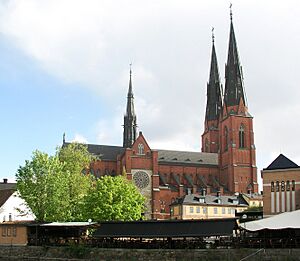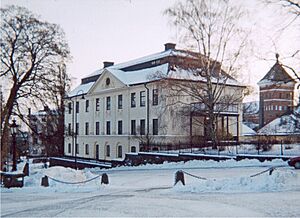Archbishop of Uppsala facts for kids
Quick facts for kids {{{name}}} |
|
|---|---|

Coat of arms
|
|
| Location | |
| Country | Sweden |
| Information | |
| Established | 1164 |
| Cathedral | Uppsala Cathedral |
The Archbishop of Uppsala is the main leader of the church in Sweden. This important role has existed since 1164. At first, the Archbishop was part of the Roman Catholic Church. But from the 1530s, the role became part of the Lutheran church. The Archbishop's official home is in Uppsala.
A Look at History
Bishops have been in Uppsala since the 1000s. Back then, they were guided by the archbishop in Hamburg-Bremen. But in 1164, Uppsala became its own archbishopric. This meant it had its own main bishop.
At first, the archbishop in Lund (which was part of Denmark) was the top leader for Sweden. He had the right to choose and officially appoint the Uppsala archbishop. But Uppsala wanted to be more independent. In 1274, Folke Johansson Ängel went directly to Rome. He was appointed by the Pope himself. This became more common. By 1318, no Uppsala archbishop was appointed by Lund anymore. In 1457, Archbishop Jöns Bengtsson (Oxenstierna) was allowed by the Pope to declare himself the top leader of Sweden.
Uppsala was originally a small village. It was located a few miles north of the current city. This old place is now called Gamla Uppsala (Old Uppsala). In 1273, the archbishop's main church moved. It moved to a market town called Östra Aros. This town then became known as Uppsala.

In 1531, King Gustav I of Sweden chose Laurentius Petri to be archbishop. This took away the Pope's power in Sweden. It also made Sweden a Protestant country. The archbishop was then called primus inter pares. This means "first among equals." The archbishop leads his own area. He is also the main leader of the Swedish church. But he doesn't have more power than other bishops. Still, his words are very important. Since 1990, the Archbishop of Uppsala has help from another bishop. Karin Johannesson is the current Bishop of Uppsala (as of 2022).
Famous Archbishops
Many archbishops did important work. Some were dedicated church leaders. Others were experts in church law. Some were important government officials. For example, Jacob Ulfsson Örnfot was a church leader and royal advisor. He also helped start Uppsala University. He even helped bring printing to Sweden.
There were also scholars. Johannes Magnus wrote books about Swedish history. His brother Olaus Magnus also wrote about northern peoples. He was the last Catholic Archbishop of Uppsala.
Church leaders also worked with religious orders. These were groups like Benedictines and Dominicans. A Swedish researcher, Carl Silfverstolpe, said: "Monks were almost the only link in the Middle Ages. They connected the culture of the north with southern Europe. Their connections helped bring higher culture to our country."
Here are some other notable archbishops:
- Birger Gregersson (1366–83) - a writer of hymns.
- Jöns Bengtsson (Oxenstierna) (1448–67) - a leader of Sweden.
- Jakob Ulfsson (1470–1514) - founded Uppsala University.
- Laurentius Petri (1531–73) - a key figure in the Swedish Lutheran reformation.
- Erik Benzelius the Elder (1700–09) - very knowledgeable.
- Nathan Söderblom (1914–1931) - won the Nobel Peace Prize.
Earliest Bishops
The first mention of a bishop in Uppsala is from the 1060s. A writer named Adam of Bremen wrote about Adalvard the Younger. He was appointed bishop for Sigtuna and Uppsala. But Swedish records don't mention him.
Medieval writings mention a Bishop Henry in Uppsala in 1129. He helped consecrate a new church. This Bishop Henry died in a battle in 1134. He was fighting with the Danes after being forced out of Sweden. He had fled from Sigtuna to Denmark. He is not in the first list of bishops from the 1400s. That list names Sverinius, Nicolaus, Sveno, Henricus, and Kopmannus. Only their names are given, except for Henricus.
See Also
- List of archbishops of Uppsala
|


